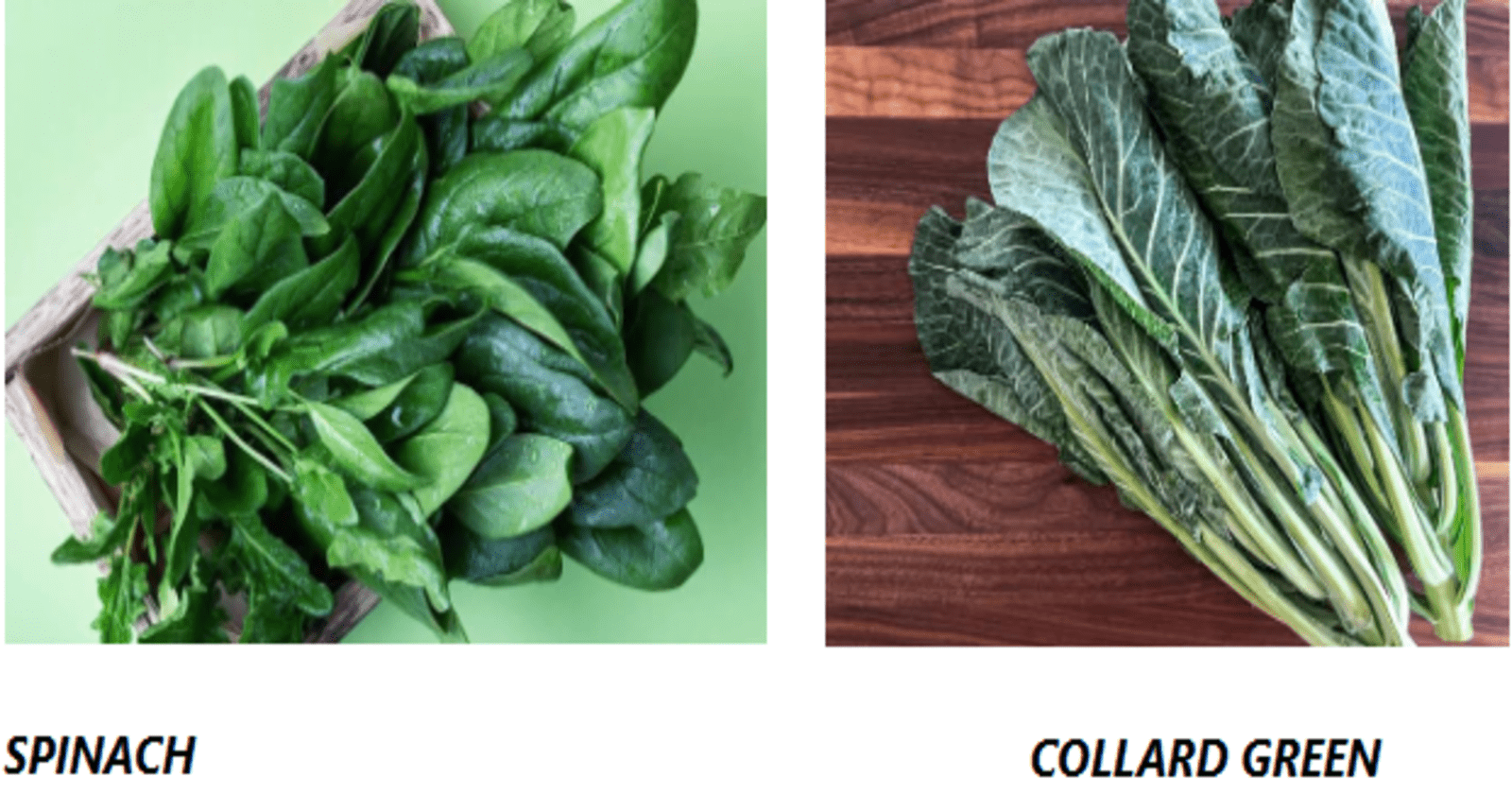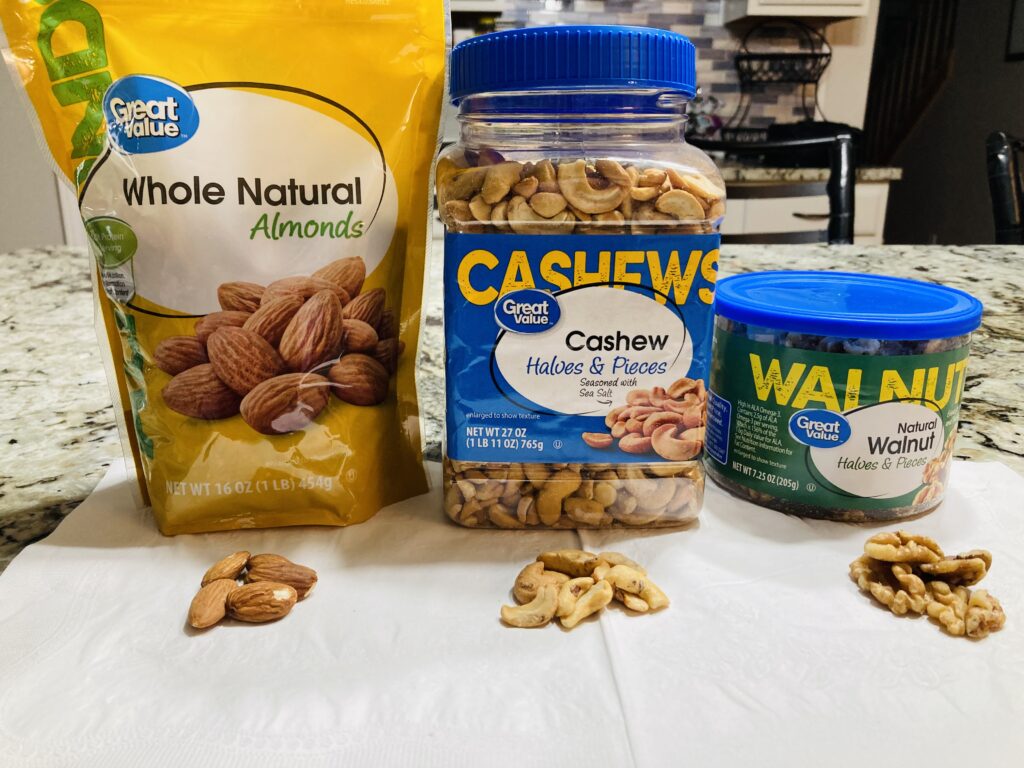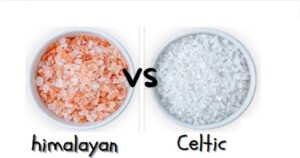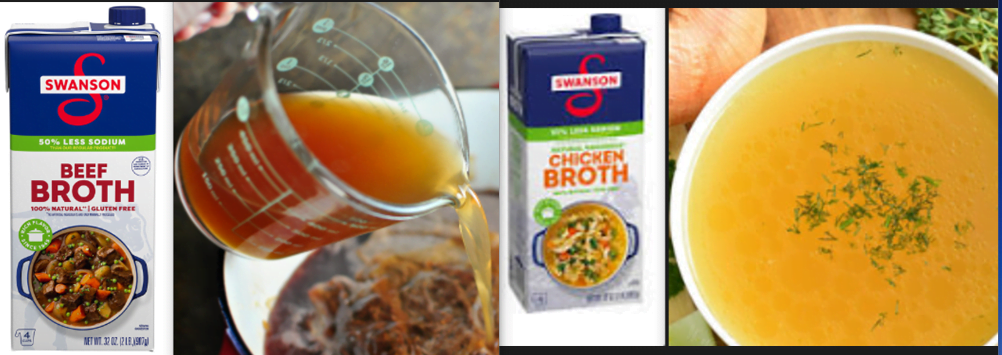Spinach (Spinacia oleracea) belongs to the Amaranthaceae family (formerly classified under Chenopodiaceae). Collard green (Brassica oleracea, variety acephala) belong to the Brassicaceae family, which is also known as the mustard or cabbage family.both nutritious leafy green vegetables that are packed with essential vitamins, minerals, and fiber, making them excellent additions to a balanced diet.
While both are highly nutritious, they do have some differences in taste and texture, which can influence how they’re used in cooking. Spinach is more delicate and can be eaten raw or cooked quickly, while collard greens are heartier and benefit from longer cooking times to tenderize the leaves.

SPINACH

COLLARD GREEN
Differences between spinach and collard greens
| Spinach | Collard Greens |
|---|---|
| Botanical Family: Amaranthaceae (same as beets, quinoa) | Botanical Family: Brassicaceae (same as kale, broccoli) |
| Leaf Structure: Small, tender, smooth leaves | Leaf Structure: Large, thick, fibrous leaves |
| Color: Dark green, often brighter | Color: Dark green with a slightly blue-green hue |
| Flavor: Mild, slightly sweet | Flavor: Earthy, robust, slightly bitter |
| Texture: Soft, tender | Texture: Tougher, chewy |
| Nutrient Content: High in iron, magnesium, and folate | Nutrient Content: High in calcium, vitamin K, and vitamin A |
| Calories (per 100g)~23 calories | Calories (per 100g)~32 calories |
| Vitamin C Content: Moderate | Vitamin C Content: High |
| Cooking Time: Quick, wilts easily | Cooking Time: Longer, requires more cooking |
| Salads, smoothies, sautéing, soups | Braised, stews, soups, boiled |
| Seasonality: Available year-round, peak in spring | Seasonality: Available year-round, peak in winter |
| Storage: Best used fresh, short shelf life | Storage: Can be stored longer, more durable |
What is Spinach
Spinach is abundant in essential nutrients like iron, vitamin, A, C and E, potassium, folate and magnesium. When incorporated into a balanced diet, it can bolster immune function, promote healthy digestion, and potentially exhibit anticancer properties. Nevertheless, some individuals may benefit from consuming this vegetable in moderate quantities.
Spinach is an excellent source of iron, which helps your body make hemoglobin. Hemoglobin helps transport oxygen from your lungs to the rest of your body.
Spinach contributes a notable amount of protein to your diet. In fact, every 100 grams of spinach provides nearly 2.9 grams of this essential nutrient.

Nutrients per serving
- Serving size: 1 cup
- Calories: 7
- Carbs: 1 gram
- Fat: 0 grams
Key Characteristics of spinach
Spinach:
- Scientific Name: Spinacia oleracea.
- Appearance: Dark green, tender leaves with a slightly glossy texture.
- Flavor: Mild, slightly earthy taste.
- Nutrition: Rich in vitamins A, C, K, and folate, as well as minerals like iron, calcium, and magnesium.
- Health Benefits: Supports eye health, aids in digestion, and boosts the immune system.
- Cooking: Can be eaten raw in salads or cooked in various dishes like stir-fries, soups, and omelets.
6 Health Benefits of Spinach
- Lowering Blood Pressure: Spinach is rich in potassium, a mineral known to help lower blood pressure.
- Healthy Eyes: Spinach contains lutein, an antioxidant that protects against age-related eye diseases such as macular degeneration and cataracts. Lutein supplementation has been linked to a lower risk of macular degeneration.
- Better Thinking Skills: Lutein in spinach has been associated with preserved cognitive abilities in older adults, including better verbal fluency, memory, reasoning ability, and processing speed.
- Healthy Bones: Spinach is a great source of vitamin K, which is essential for bone health and growth.
- Healthy Skin: The vitamin A in spinach supports skin health by aiding tissue growth, supporting the skin’s immune system, and helping maintain hydration. This may reduce the appearance of fine lines and wrinkles.
- Healthy Blood: Spinach is an excellent source of iron, crucial for hemoglobin production. Hemoglobin transports oxygen from the lungs to the rest of the body, and iron deficiency can lead to fatigue.
12 Types of Spinach, each with its own unique characteristics
- Savoy Spinach (Spinacia oleracea var. Savoy): This type of spinach has crinkled, curly leaves and is known for its tender texture and mild flavor.
SAVOY SPINACH Distinct features

- Versatility in Cooking: Savoy spinach can be used in a variety of culinary applications. It can be eaten raw in salads, wilted in stir-fries, soups, and stews, or used as a filling in dishes like quiches and spanakopita.
- Growth Habit: Like other spinach varieties, Savoy spinach is an annual plant that typically grows in a rosette shape, with leaves radiating from a central point.
- Cultivation: It’s important to note that the Savoy spinach variety may have specific cultivation requirements. It typically thrives in cool weather and can tolerate light frosts. It’s often grown in early spring or late summer for a fall harvest.
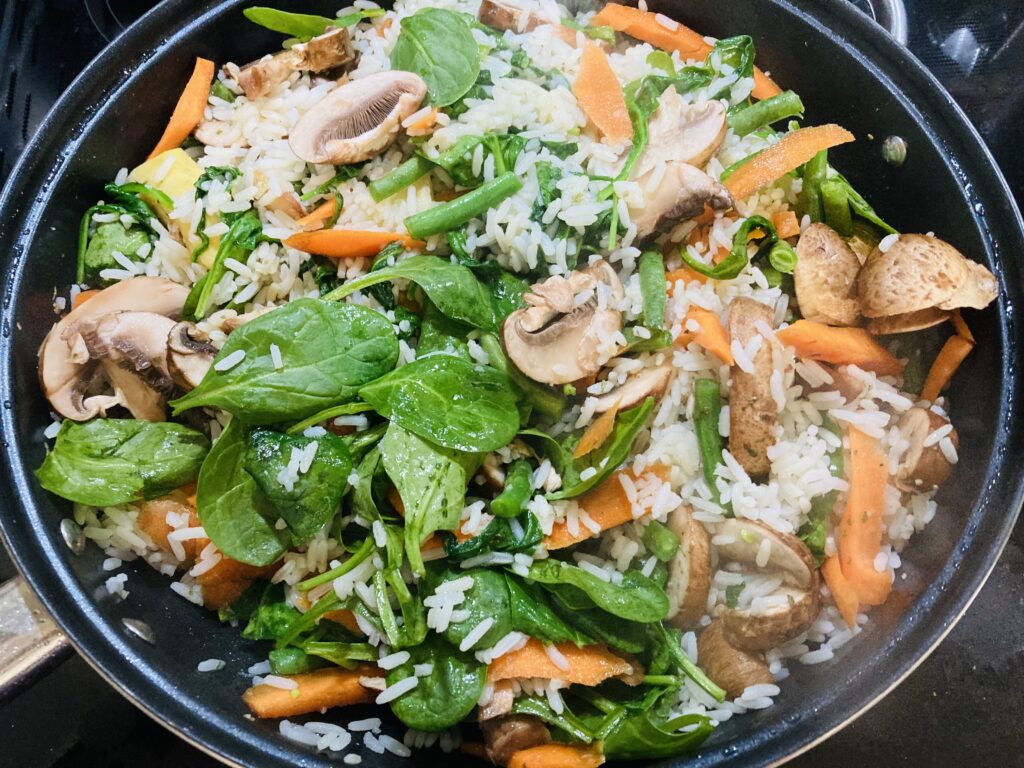
- Leaf Texture: Savoy spinach has crinkled or blistered leaves. These leaves have a wrinkled appearance, which sets them apart from flat-leaf varieties.
- Color: The leaves are a deep, dark green. The color may vary slightly depending on factors like maturity and growing conditions.
- Flavor: The taste of Savoy spinach is often described as robust and earthy, with a slightly nutty undertone. It is known for its rich, full flavor.
- Nutritional Content: Like other spinach varieties, Savoy spinach is a highly nutritious leafy green. It’s an excellent source of vitamins (such as vitamin A, C, K, and folate), minerals (like iron, calcium, and potassium), and dietary fiber.
- Texture After Cooking: Due to its crinkled leaves, Savoy spinach can retain more moisture after cooking compared to flat-leaf varieties. This can result in a slightly different texture when cooked.
- Versatility in Cooking: Savoy spinach can be used in a variety of culinary applications. It can be eaten raw in salads, wilted in stir-fries, soups, and stews, or used as a filling in dishes like quiches and spanakopita.
- Growth Habit: Like other spinach varieties, Savoy spinach is an annual plant that typically grows in a rosette shape, with leaves radiating from a central point.
- Cultivation: It’s important to note that the Savoy spinach variety may have specific cultivation requirements. It typically thrives in cool weather and can tolerate light frosts. It’s often grown in early spring or late summer for a fall harvest.
2. Flat-Leaf Spinach (Spinacia oleracea var. Smooth Leaf): Also known as smooth-leaf or flat-leaf spinach, this variety has smooth, broad leaves. It’s often preferred for its ease of cleaning and cooking.
3. Semi-Savoy Spinach (Spinacia oleracea var. Semi-Savoy): Semi-savoy spinach is a hybrid variety that combines characteristics of savoy and flat-leaf spinach. It has slightly crinkled leaves, making it easier to clean than savoy but with some of the texture.
4. Baby Spinach: This is not a specific variety but rather a term used to describe young, tender spinach leaves. Baby spinach is typically harvested at an early stage of growth when the leaves are small and tender.

5.Bloomsdale Spinach: Bloomsdale is a popular heirloom variety known for its crinkled, dark green leaves. It’s a savoy-type spinach with a robust flavor.
6.Tyee Spinach: Tyee is a relatively new hybrid spinach variety that is known for its disease resistance and high yield. It has dark green, smooth leaves.
7.Space Spinach: This variety is specifically bred for its ability to grow in limited space, making it a good choice for container gardening or small garden plots.
8.Melody Spinach: Melody is a variety known for its slow bolting (going to seed) and high resistance to downy mildew. It produces glossy, dark green leaves.
9.Corvair Spinach: Corvair is a semi-savoy variety that is known for its resistance to bolting and disease. It has slightly crinkled, dark green leaves. Well-suited for both spring and fall cultivation, this variety boasts high yield potential and demonstrates adaptability across a wide range of conditions. Additionally, it exhibits resistance to downy mildew.

10.New Zealand Spinach (Tetragonia tetragonioides): While not technically related to true spinach, New Zealand spinach is a heat-tolerant alternative. It has succulent, triangular leaves and a similar flavor profile.
11.Red Malabar Spinach (Basella alba): Another spinach alternative, Red Malabar Spinach, is a vining plant with succulent, red-tinged leaves. It’s often used in salads or as a cooking green.
A vibrant variety of spinach with red-colored stems and leaves. This spinach is known for its unique appearance and is a popular choice among gardeners and culinary enthusiasts.
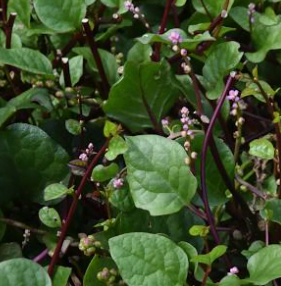
12.Indian Summer Spinach (Amaranthus tricolor): This is another warm-season spinach substitute. It’s not from the Spinacia genus but is used in similar culinary ways.
Remember that availability may vary depending on your location and local nurseries or seed suppliers. When choosing a type of spinach, consider factors like your local climate, available space, and personal taste preferences.

5 Key Factors and Challenges in Growing Spinach
Growing spinach successfully involves understanding several key factors and addressing various challenges. Here are some important considerations:
1. Climate and Temperature Requirements
- Factor: Spinach thrives in cool weather, with optimal growth occurring in temperatures between 50°F and 60°F (10°C to 15°C).
- Challenge: High temperatures can cause spinach to bolt (go to seed), which makes the leaves bitter and less palatable. In warm climates, timing the planting to avoid hot weather is crucial.
2. Soil Quality and pH Levels
- Factor: Spinach prefers well-drained, loamy soil rich in organic matter with a slightly acidic to neutral pH (6.0 to 7.5).
- Challenge: Poor soil drainage can lead to root rot, while highly acidic or alkaline soils can inhibit nutrient uptake, affecting plant growth.
3. Watering Practices
- Factor: Consistent moisture is essential for spinach growth, as the plant has shallow roots.
- Challenge: Overwatering can lead to fungal diseases like downy mildew, while underwatering can cause the plant to wilt and reduce leaf quality.
4. Pest and Disease Management
- Factor: Common pests include aphids, leaf miners, and slugs, while diseases like downy mildew and fusarium wilt can affect spinach.
- Challenge: Managing these pests and diseases organically or through integrated pest management (IPM) is essential to avoid using harmful chemicals that can affect the plant and the environment.
5. Nutrient Management
- Factor: Spinach requires a balanced supply of nutrients, particularly nitrogen, to produce lush, green leaves.
- Challenge: Over-fertilization, particularly with nitrogen, can lead to excessive leaf growth at the expense of root development, and may also contribute to environmental issues like nutrient runoff. Conversely, nutrient deficiencies can stunt growth and reduce yield.
Considerations or limitations of Spinach
There are a few limitations associated with spinach:
- Oxalates: Spinach contains oxalates, which can crystallize and cause health issues for those with kidney problems or a history of kidney stones.
- High in Purines: People with gout should consume spinach in moderation as it contains purines, which can exacerbate the condition.
- Interference with Mineral Absorption: Spinach contains compounds like oxalic acid and phytates that can hinder the absorption of certain minerals like calcium and iron.
- Risk of Pesticide Residues: Conventionally grown spinach may carry pesticide residues, so opting for organic varieties can be beneficial.Despite its numerous health benefits, spinach does come with potential risks, often associated with its production and packaging. The nonprofit organization Environmental Working Group has consistently placed spinach near the top of its yearly list of foods that may contain pesticide residues.
- Allergies: Some individuals may have allergic reactions to spinach, although this is relatively rare.
- Potential for Contamination: Spinach, especially if not properly washed, can sometimes harbor harmful bacteria like E. coli, so thorough cleaning is essential.
- Thyroid Interference: Spinach contains goitrogens, which can interfere with the thyroid function if consumed in excessive amounts.
- Vitamin K Interaction: Individuals on blood thinners need to monitor their vitamin K intake, as spinach is high in this nutrient, which can affect blood clotting.
- FODMAP Content: Spinach contains some fermentable carbohydrates (FODMAPs), which can cause digestive discomfort for individuals sensitive to them.
- High Fiber: Spinach is rich in fiber, which, when consumed in excess, can lead to symptoms like gas, cramping, and abdominal discomfort.
It’s worth noting that while these limitations exist, spinach is still a highly nutritious vegetable and provides numerous health benefits when consumed in moderation and as part of a balanced diet. Consulting a healthcare professional or a registered dietitian for personalized advice is always recommended, especially for those with specific health concerns or dietary restrictions.
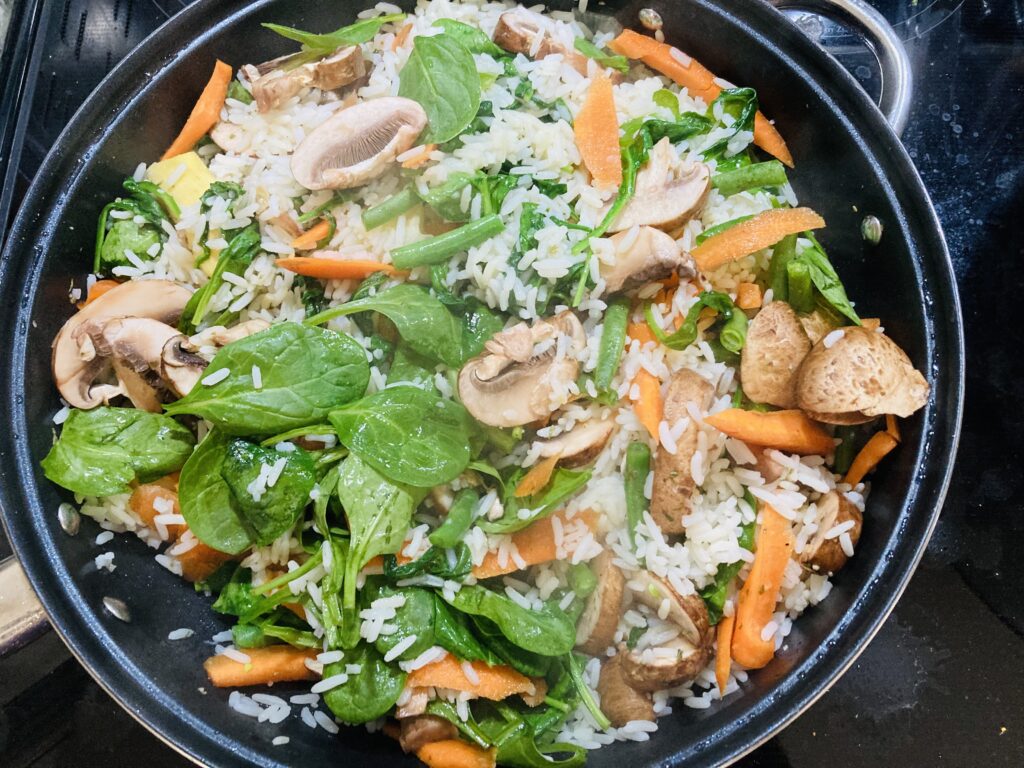
Collard Greens vs Spinach: Nutrient Density and Health Advantages
When comparing collard greens and spinach, both are nutrient-dense leafy greens that offer significant health benefits, but they differ in nutrient composition and specific advantages. Here’s a breakdown:
Nutrient Density
Collard Greens:
- Vitamin K: Extremely high in vitamin K, which is important for blood clotting and bone health. One cup of cooked collard greens provides over 1,000% of the daily recommended intake.
- Vitamin A: Rich in vitamin A, which supports vision and immune function.
- Vitamin C: Good source of vitamin C, important for immune function and skin health.
- Calcium: Collard greens are one of the best plant sources of calcium, essential for bone health, especially for those who do not consume dairy.
- Fiber: High in dietary fiber, which supports digestive health and helps regulate blood sugar levels.
- Antioxidants: Contains antioxidants like lutein and zeaxanthin, which are beneficial for eye health.
Spinach:
- Vitamin A: Spinach is very high in vitamin A, mainly in the form of beta-carotene, which is vital for vision and immune function.
- Vitamin K: Also rich in vitamin K, though slightly less than collard greens.
- Folate: High in folate, important for DNA synthesis and repair, making it crucial during pregnancy.
- Iron: Spinach is well-known for its iron content, though it is non-heme iron, which is less readily absorbed by the body compared to heme iron from animal sources.
- Magnesium: A good source of magnesium, which is important for muscle and nerve function, as well as bone health.
- Antioxidants: Contains powerful antioxidants like quercetin and kaempferol, which have anti-inflammatory and anti-cancer properties.
Health Advantages
Collard Greens:
- Bone Health: Due to its high calcium and vitamin K content, collard greens are particularly beneficial for bone health.
- Digestive Health: The high fiber content supports digestion and helps prevent constipation.
- Blood Clotting: The extremely high levels of vitamin K in collard greens are beneficial for proper blood clotting.
- Cardiovascular Health: The fiber and antioxidant content help in reducing cholesterol levels and protecting against heart disease.
Spinach:
- Vision: Spinach’s high beta-carotene and lutein content make it particularly good for eye health.
- Anemia Prevention: The iron content in spinach can help prevent anemia, though it is better absorbed when consumed with vitamin C-rich foods.
- Pregnancy Health: The high folate content is essential for pregnant women, helping prevent neural tube defects.
- Anti-inflammatory: The antioxidants in spinach, such as quercetin, have strong anti-inflammatory properties, which can help reduce the risk of chronic diseases.
Simple Nutritional facts Spinach vs Collard Greens
| Spinach (Raw) Nutrient | Collard Greens (Raw) Nutrient |
|---|---|
| Calories 23 | Calories 32 |
| Protein 2.9g | Protein 2.1g |
| Total Fat 0.4g | Total Fat 0.6g |
| Carbohydrates 3.6g | Carbohydrates 6g |
| Fiber 2.2g | Fiber 4g |
| Sugars 0.4g | Sugars 0.5g |
| Vitamin A (IU) 4696 IU | Vitamin A (IU) 3333 IU |
| Vitamin C 47.9mg | Vitamin C 35.3mg |
| Calcium 99mg | Calcium 145mg |
| Iron 2.7mg | Iron 0.4mg |
| Vitamin K 482.9mcg | Vitamin K 418.4mcg |
Please note that these values are approximate and can vary based on factors such as cooking methods and specific varieties of spinach or collard greens. It’s always a good idea to refer to specific nutritional information on packaging or consult with a nutritionist for precise details.
Important Facts When Storing Spinach
- Refrigeration: Store fresh spinach in the refrigerator. Place it in the vegetable crisper drawer, preferably in a perforated plastic bag or a loosely closed plastic bag. The perforations allow for proper air circulation, preventing excess moisture buildup.
- Remove Excess Moisture: Excess moisture can lead to the growth of mold and spoilage. Before storing, make sure the spinach is dry. You can pat it gently with a paper towel or use a salad spinner to remove excess water.
- Avoid Freezing: While you can freeze spinach for later use in cooked dishes like soups or smoothies, freezing can change its texture, and it’s not ideal for fresh salads. If you plan to freeze spinach, blanch it first and store it in airtight containers or freezer bags.
- Store Unwashed: It’s generally best to store spinach unwashed. Washing it before storing can introduce excess moisture, leading to quicker spoilage. Instead, wash it just before use.
- Use airtight containers: If you’ve opened a bag of pre-washed spinach, transfer any remaining leaves to an airtight container to help maintain freshness.
- Check for Spoilage: Regularly check your stored spinach for any signs of spoilage, such as wilting, sliminess, or a foul odor. Remove any damaged leaves promptly to prevent the spread of spoilage.
What is Collard greens?
Collard greens are a nutritional powerhouse, boasting a wealth of essential nutrients like iron, magnesium, calcium, potassium, and vitamins A, C, and K. Their fiber content supports healthy digestion and helps reduce cholesterol levels. Additionally, these greens are packed with antioxidants and have a low glycemic index, making them an excellent addition to your diet for overall well-being.
Collard greens are a leafy green vegetable that belongs to the Brassica oleracea family, which also includes cabbage, broccoli, and Brussels sprouts. There are several types of collard greens, though the most commonly known and cultivated variety is the Acephala group. Within this group, there are different cultivars and varieties.
A Soul Food Video on how to make Collard greens
Health Benefits of Collard green
| Health Benefit | Description |
|---|---|
| Rich in Nutrients | Good source of vitamins A, C, and K, as well as folate, manganese, calcium, and potassium. |
| High in Fiber | Excellent source of dietary fiber, promoting digestive health, regular bowel movements, and aiding in weight management. |
| Antioxidant Properties | Contains beta-carotene, lutein, and zeaxanthin, which neutralize free radicals and reduce oxidative stress. |
| Anti-Inflammatory Effects | Presence of phytonutrients, such as glucosinolates, contributes to anti-inflammatory properties. |
| Heart Health | Fiber, potassium, and omega-3 fatty acids contribute to lower blood pressure and improved cardiovascular function. |
| Bone Health | Excellent source of vitamin K and calcium, crucial for strong and healthy bones. |
| Blood Sugar Control | High fiber content helps regulate blood sugar levels, beneficial for diabetes management. |
| Supports Detoxification | Compounds like sulfur-containing glucosinolates may support the body’s detoxification processes. |
Within this group, there are different cultivars and varieties. Here are some types of collard greens:
Nutritional value one Cup Collard green per Serving

One cup of fresh collard greens contains
- Calories: 11
- Protein: 1 gram
- Fat: Less than 1 gram
- Carbohydrates: 2 grams
- Fiber: 1 gram
- Sugar: Less than 1 gram
Here are some key characteristics of collard greens:
Collard Greens:
- Scientific Name: Brassica oleracea var. acephala.
- Appearance: Large, dark green leaves with a tough central stem.
- Flavor: Robust, slightly bitter taste (more so than spinach).
- Nutrition: High in vitamins A, C, and K, as well as folate, calcium, and fiber.
- Health Benefits: Promotes heart health, supports bone health, and aids in digestion.
- Cooking: Commonly cooked by boiling, steaming, or sautéing. Often served as a side dish, particularly in Southern cuisine.
Including a variety of leafy greens like spinach and collard greens in your diet can provide a range of essential nutrients and contribute to overall health and well-being.
10 different Types of collard greens:
- Georgia Southern Collard Greens: This is the most widely recognized and grown variety of collard greens. It is known for its large, dark green, crinkly leaves.
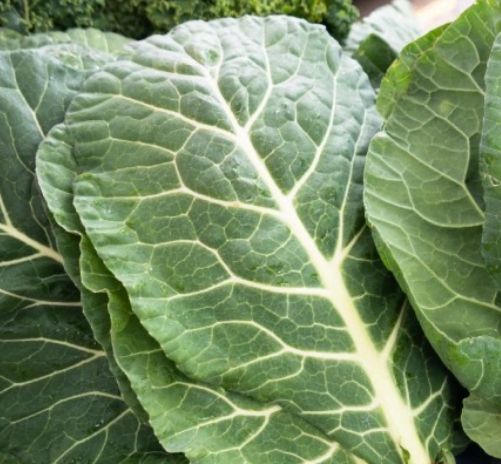
2.Vates Collard Greens: This variety is similar to the Georgia Southern but tends to have slightly smaller leaves. It’s a more compact plant, making it suitable for smaller gardens. Large, deep green, rounded leaves with a subtle crinkled texture exhibit cabbage like look and a mild cabbage-like taste that becomes more pronounced with a gentle frost.
In temperate regions, collard greens thrive throughout winter without interruption, allowing for continuous harvesting over the course of several months. The flavor is particularly enhanced during cooler weather, making it an ideal time for peak condition and quality.
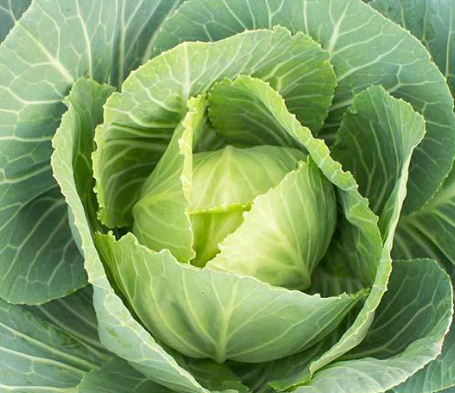
3.Morris Heading Collard Greens: This type of collard green produces a central head, similar to cabbage, which is unusual for collards. It has smooth, dark green leaves.
4.Top Bunch Collard Greens: This variety is known for producing an abundance of tender, sweet leaves. It’s often favored for its improved flavor and texture.
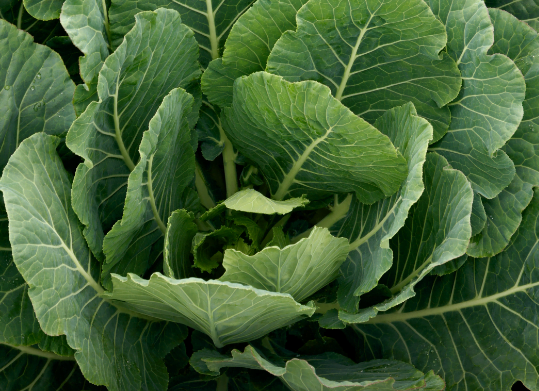
5.Blue Max Collard Greens: Blue Max is a relatively newer cultivar known for its blue-green, large, and slightly crinkled leaves. It’s resistant to bolting (going to seed prematurely).
6.Champion Collard Greens: This variety is valued for its cold hardiness. It has dark green leaves and is a reliable choice for fall and winter gardening.
7.Flash Collard Greens: Flash is a hybrid collard green variety known for its rapid growth and high yield. It produces smooth, dark green leaves.
8.Green Glaze Collard Greens: This variety is characterized by its glossy, deep green leaves. It’s known for being disease-resistant and tends to hold up well in various growing conditions.
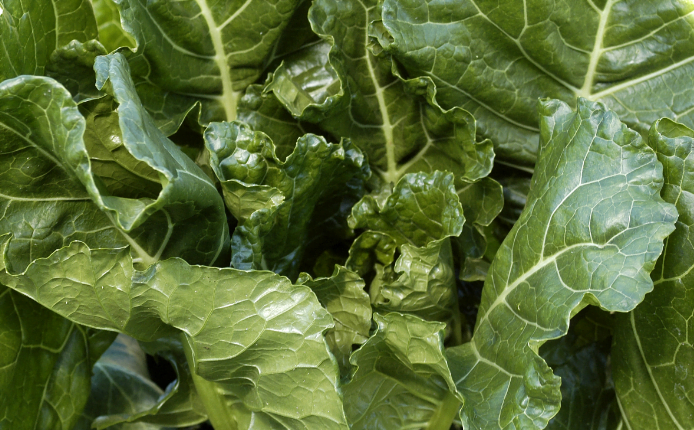
9.Early Spring Collard Greens: As the name suggests, this variety is bred for early spring planting. It matures quickly, allowing for an early harvest.
10.Yellow Cabbage Collard Greens: This cultivar is unique in that it produces yellow-green leaves. It has a milder flavor compared to some other varieties.
Remember that availability might vary depending on your location and local nurseries or seed suppliers. When choosing a type of collard greens, consider factors like your local climate, available space, and personal taste preferences.
Consideration or Limitations of Collard Green
- Oxalates: Like spinach, collard greens contain oxalates, which can crystallize and pose problems for individuals with kidney issues or a history of kidney stones.
- Digestive Discomfort: Collard greens are high in fiber, which can lead to gas, bloating, and abdominal discomfort, especially if consumed in large quantities or for those with sensitive digestive systems.
- Thyroid Interference: Collard greens, like other cruciferous vegetables, contain goitrogens which, when consumed in excessive amounts, can interfere with thyroid function.
- Interaction with Blood Thinners: Collard greens are high in vitamin K, which can affect blood clotting. This may be a concern for individuals on blood thinning medications.
- Contamination Risk: If not thoroughly washed, collard greens may harbor harmful bacteria, so proper cleaning is crucial.
- Potential for Allergies: Some individuals may have allergic reactions to collard greens, though this is relatively uncommon.
- High in Vitamin A: While vitamin A is important for health, excessive intake from sources like collard greens can lead to hypervitaminosis A, which can have adverse effects.
- FODMAP Content: Collard greens contain fermentable carbohydrates (FODMAPs), which can cause digestive discomfort for individuals sensitive to them.
- Pesticide Residues: Conventionally grown collard greens may carry pesticide residues, so opting for organic varieties can be beneficial.
Despite these limitations, collard greens are a valuable source of nutrients and offer various health benefits. As with any food, moderation and balanced consumption are key. If you have specific health concerns or dietary restrictions, consulting a healthcare professional or a registered dietitian is advisable.
Differences between Spinach and Collard green
SPINACH
Taste and Texture:
Spinach has tender, delicate leaves and a mild, slightly earthy flavor. It can be eaten raw in salads or cooked in various dishes.
Nutritional Content
- Rich in vitamins and minerals, particularly vitamin K, vitamin A, folate, iron, and calcium.
- Low in calories but high in fiber, making it beneficial for digestion.
- Contains antioxidants, such as lutein and zeaxanthin, which are good for eye health.
Culinary Uses:
- Can be eaten raw in salads or sandwiches.
- Cooked spinach can be used in a variety of dishes, including soups, stews, quiches, and as a filling for pastries like spanakopita.
Cultural and Regional Use:
Spinach is used in a wide range of global cuisines, from Mediterranean salads to Indian curries.
Storage and Shelf Life:
Spinach tends to have a shorter shelf life and can wilt quickly. It’s best stored in a plastic bag in the refrigerator and used within a few days.
Culinary Flexibility:
Spinach is highly versatile and can be used in a wide range of dishes, both cooked and raw.
COLLARD GREEN
Taste and Texture:
Collard greens have tougher, thicker leaves and a more robust, slightly bitter flavor. They require longer cooking times to become tender.
Nutritional Content
- Also high in vitamin K, vitamin A, and folate, but tends to have higher levels of these nutrients compared to spinach.
- Excellent source of fiber, making it beneficial for digestive health.
- Collard greens are known for being particularly rich in calcium, which is important for bone health.
Culinary Uses:
- Typically cooked before consuming, often boiled, steamed, or sautéed.
- Commonly served as a side dish, often with ingredients like garlic, onion, and ham hock for flavor.
Cultural and Regional Use:
Collard greens are a staple in Southern U.S. cuisine, where they are often cooked with ingredients like bacon or ham hock.
Storage and Shelf Life:
Collard greens are more resilient and can last longer in the refrigerator. They can be stored similarly to other greens, like kale or Swiss chard.
Culinary Flexibility:
Collard greens have a more specific culinary use and are primarily consumed after being cooked.
How to Store Collard Green
Storing collard greens properly can help maintain their freshness and quality for a longer period. Here are some tips on how to store collard greens:
- Refrigeration:
- Collard greens should be stored in the refrigerator to slow down the deterioration process.
- Place the unwashed collard greens in a plastic bag. You can use the produce bags typically available in grocery stores or a resealable plastic bag with holes punched for ventilation.
- Squeeze out as much air as possible before sealing the bag. Excess air can lead to quicker deterioration.
- Temperature:
- Keep collard greens in the vegetable crisper drawer of the refrigerator. The ideal temperature for storing collard greens is around 32°F to 40°F (0°C to 4°C).
- Moisture:
- Moisture can lead to the growth of mold and bacteria, so it’s essential to keep the collard greens dry.
- If the collard greens are damp, you can pat them dry with a paper towel before storing them in the refrigerator.
- Separation:
- Store collard greens away from fruits like apples and bananas, as these release ethylene gas, which can accelerate the ripening and deterioration of collard greens.
- Washing Before Use:
- It’s best to wash collard greens just before using them. Washing them before storage can introduce excess moisture, which can lead to spoilage.
- Freezing (for Long-Term Storage):
- If you have a large quantity of collard greens and want to store them for an extended period, consider blanching them before freezing. Blanching involves briefly immersing the greens in boiling water and then quickly cooling them in ice water before freezing. This helps to preserve the color, texture, and nutritional value.
Medication that can interact with Spinach and Collard Green
Spinach Medication Interaction
There are some medications and conditions for which spinach intake may need to be monitored or restricted. It’s always important to consult with a healthcare professional or pharmacist for personalized advice based on your specific medical history and medications. Here are a few examples:
- Warfarin (Coumadin): Spinach contains high levels of vitamin K, which can interfere with the anticoagulant effects of warfarin. Consistent intake of vitamin K-containing foods, including spinach, is usually recommended to be consistent to avoid fluctuations in warfarin effectiveness. If you are on warfarin, your healthcare provider may advise you to maintain a stable vitamin K intake.
- Calcium Channel Blockers: Some calcium channel blockers, such as verapamil, may interact with high levels of potassium found in certain foods, including spinach. While spinach is not extremely high in potassium, it’s still a good idea to discuss your diet with your healthcare provider if you are taking these medications.
- Tetracycline Antibiotics: Spinach, along with other foods high in calcium, may interfere with the absorption of tetracycline antibiotics. It’s generally recommended to avoid consuming dairy products, antacids, and high-calcium foods within a few hours of taking tetracycline antibiotics.
Collard Green Medication Interactions
- Warfarin (Coumadin): Warfarin is a blood thinner, and its effectiveness can be influenced by vitamin K intake. Consistent intake of vitamin K is important to maintain the stability of warfarin levels.
- Other Anticoagulants: Similar to warfarin, other anticoagulant medications may be affected by changes in vitamin K intake. Examples include dabigatran (Pradaxa), rivaroxaban (Xarelto), and apixaban (Eliquis).
- Vitamin K Supplements: If you are taking vitamin K supplements, it’s important to coordinate their use with your healthcare provider, especially if you are on medications that are sensitive to vitamin K levels.
How to grow collard green during winter season.
Growing collard greens during the winter season can be quite successful, as they are a cold-hardy vegetable that can tolerate frost and even improve in flavor after exposure to light freezes. Here’s a step-by-step guide to growing collard greens during winter:
1. Choosing the Right Variety
- Varieties: Select cold-tolerant varieties like ‘Georgia’, ‘Champion’, or ‘Vates’. These are known for their resilience to colder temperatures and ability to thrive in winter conditions.
2. Timing the Planting
- Planting Time: Collard greens can be planted in late summer to early fall, allowing them to establish before the coldest weather sets in. For winter harvesting, plant them about 6-8 weeks before the first expected frost.
3. Soil Preparation
- Soil Type: Prepare well-drained, loamy soil rich in organic matter. Collard greens prefer soil with a pH of 6.0 to 6.8.
- Amending Soil: Incorporate compost or aged manure into the soil to improve fertility. If your soil is acidic, consider adding lime to adjust the pH.
4. Planting
- Spacing: Sow seeds or transplant seedlings 18-24 inches apart in rows that are 24-36 inches apart. This spacing allows for adequate air circulation and room for growth.
- Depth: Plant seeds about ¼ to ½ inch deep. If transplanting, plant seedlings at the same depth they were in their pots.
5. Watering
- Consistent Moisture: Water regularly to keep the soil consistently moist but not waterlogged. Collard greens require about 1 to 1.5 inches of water per week, especially during dry spells.
- Mulching: Apply a layer of mulch around the plants to help retain soil moisture and regulate soil temperature.
6. Frost Protection
- Row Covers: Use row covers or fabric to protect young plants from early frosts. Collard greens can tolerate frost, but protection may be necessary during extreme cold.
- Cold Frames or Hoop Houses: In very cold climates, consider using cold frames or hoop houses to provide additional warmth and extend the growing season.
7. Fertilization
- Feeding: Apply a balanced fertilizer or a nitrogen-rich fertilizer every 4-6 weeks to promote healthy leaf growth. Avoid over-fertilizing as it can lead to overly lush growth susceptible to frost damage.
8. Pest and Disease Management
- Pests: Watch for common pests like cabbage worms, aphids, and slugs. Use organic methods such as neem oil, insecticidal soap, or hand-picking to manage them.
- Diseases: Collard greens are relatively disease-resistant, but ensure good air circulation and avoid overhead watering to prevent fungal diseases.
9. Harvesting
- When to Harvest: Collard greens can be harvested 60-85 days after planting, depending on the variety. Harvest leaves when they reach a usable size, starting from the bottom and working your way up.
- Post-Frost Harvesting: Leaves tend to sweeten after a frost, so winter harvesting can result in especially flavorful greens. Continue harvesting throughout winter, as long as the plants remain healthy.
10. Overwintering
- Perennial Growth: In milder climates, collard greens can act as perennials, surviving through the winter and regrowing in spring. Provide protection during the coldest periods to encourage this.
Common Questions people ask and answers
1. Spinach vs collard green which is best for bone health?
Collard greens, due to their high calcium and vitamin K content.
2. Spinach vs Collard green which is Best for Vision and Pregnancy?
Spinach, with its high vitamin A, folate, and iron content.
3. Spinach vs Collard which is higher in calcium and fiber?
Collard greens have an edge in calcium and fiber, while spinach excels in iron and folate.
Resources:
https://www.webmd.com/diet/health-benefits-spinach
https://en.wikipedia.org/wiki/Collard_(plant)
https://en.wikipedia.org/wiki/Spinach
https://www.webmd.com/diet/health-benefits-spinach
https://www.smartgardener.com/plants/1691-collards-vates/overview#
